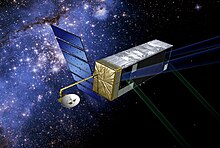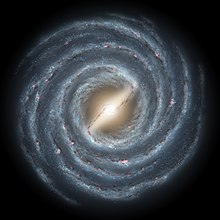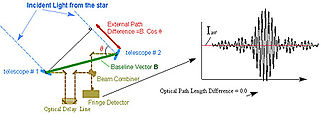
Astrometry is a branch of astronomy that involves precise measurements of the positions and movements of stars and other celestial bodies. It provides the kinematics and physical origin of the Solar System and this galaxy, the Milky Way.

The Terrestrial Planet Finder (TPF) was a proposed project by NASA to construct a system of space telescopes for detecting extrasolar terrestrial planets. TPF was postponed several times and finally cancelled in 2011. There were two telescope systems under consideration, the TPF-I, which had several small telescopes, and TPF-C, which used one large telescope.
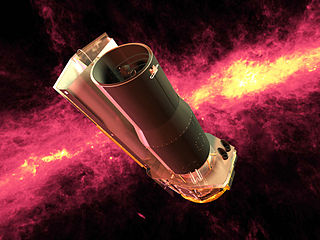
The Spitzer Space Telescope, formerly the Space Infrared Telescope Facility (SIRTF), was an infrared space telescope launched in 2003, that was deactivated when operations ended on 30 January 2020. Spitzer was the third space telescope dedicated to infrared astronomy, following IRAS (1983) and ISO (1995–1998). It was the first spacecraft to use an Earth-trailing orbit, later used by the Kepler planet-finder.

The Two Micron All-Sky Survey, or 2MASS, was an astronomical survey of the whole sky in infrared light. It took place between 1997 and 2001, in two different locations: at the U.S. Fred Lawrence Whipple Observatory on Mount Hopkins, Arizona, and at the Cerro Tololo Inter-American Observatory in Chile, each using a 1.3-meter telescope for the Northern and Southern Hemisphere, respectively. It was conducted in the short-wavelength infrared at three distinct frequency bands near 2 micrometres, from which the photometric survey with its HgCdTe detectors derives its name.

Galaxy Evolution Explorer was a NASA orbiting space telescope designed to observe the universe in ultraviolet wavelengths to measure the history of star formation in the universe. In addition to paving the way for future ultraviolet missions, the space telescope allowed astronomers to uncover mysteries about the early universe and how it evolved, as well as better characterize phenomena like black holes and dark matter. The mission was extended three times over a period of 10 years before it was decommissioned in June 2013. GALEX was launched on 28 April 2003 and decommissioned in June 2013.

Gaia is a space observatory of the European Space Agency (ESA), launched in 2013 and expected to operate until 2025. The spacecraft is designed for astrometry: measuring the positions, distances and motions of stars with unprecedented precision, and the positions of exoplanets by measuring attributes about the stars they orbit such as their apparent magnitude and color. The mission aims to construct by far the largest and most precise 3D space catalog ever made, totalling approximately 1 billion astronomical objects, mainly stars, but also planets, comets, asteroids and quasars, among others.
Darwin was a suggested ESA Cornerstone mission which would have involved a constellation of four to nine spacecraft designed to directly detect Earth-like planets orbiting nearby stars and search for evidence of life on these planets. The most recent design envisaged three free-flying space telescopes, each three to four metres in diameter, flying in formation as an astronomical interferometer. These telescopes were to redirect light from distant stars and planets to a fourth spacecraft, which would have contained the beam combiner, spectrometers, and cameras for the interferometer array, and which would have also acted as a communications hub. There was also an earlier design, called the "Robin Laurance configuration," which included six 1.5 metre telescopes, a beam combiner spacecraft, and a separate power and communications spacecraft.

Full-sky Astrometric Mapping Explorer was a NASA proposed astrometric satellite designed to determine with unprecedented accuracy the positions, distances, and motions of 40 million stars within our galactic neighborhood. This database was to allow astronomers to accurately determine the distance to all of the stars on this side of the Milky Way galaxy, detect large planets and planetary systems around stars within 1,000 light years of the Sun, and measure the amount of dark matter in the galaxy from its influence on stellar motions. It was to be a collaborative effort between the United States Naval Observatory (USNO) and several other institutions. FAME would have measured stellar positions to less than 50 microarcseconds. The NASA MIDEX mission was scheduled for launch in 2004. In January 2002, however, NASA abruptly cancelled this mission, mainly due to concerns about costs, which had grown from US$160 million initially to US$220 million.
NASA's Origins program is a decades-long study addressing the origins of the universe, various astronomical bodies, and life. The Origins program was started in the 1990s.
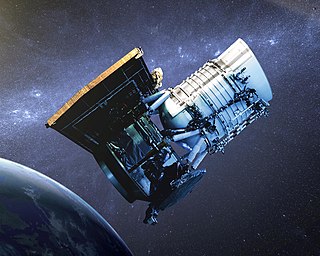
Wide-field Infrared Survey Explorer was a NASA infrared astronomy space telescope in the Explorers Program launched in December 2009. WISE discovered thousands of minor planets and numerous star clusters. Its observations also supported the discovery of the first Y-type brown dwarf and Earth trojan asteroid. WISE performed an all-sky astronomical survey with images in 3.4, 4.6, 12 and 22 μm wavelength range bands, over ten months using a 40 cm (16 in) diameter infrared telescope in Earth orbit.
PlanetQuest is NASA's education and public outreach program centered on the science and technology of NASA's long-term search for habitable planets beyond the Solar System.
Stephen J. Edberg is a scientist at the Jet Propulsion Laboratory. He is perhaps best known for creating collaborative efforts between amateur and professional astronomers. A professional astronomer since 1970, Edberg still considers himself to be an active amateur astronomer as well and is an active astronomical observer, photographer, and telescope maker. He presently serves as staff astronomer for the Solar System Exploration website posted by NASA Headquarters and staff scientist for Earth science communication and for Exoplanet Exploration communication.

TAU was a proposed uncrewed interstellar probe that would go to a distance of one thousand astronomical units from the Earth and Sun by the NASA Jet Propulsion Laboratory in 1987 using tested technology. One scientific purpose would be to measure the distance to other stars via stellar parallax. Studies continued into 1990, working with a launch in the 2005–2010 timeframe.

Multiple satellite imaging is the process of using multiple satellites to gather more information than a single satellite so that a better estimate of the desired source is possible. So something that cannot be seen with one telescope might be visible with two or more telescopes.

The 215th meeting of the American Astronomical Society (AAS) took place in Washington, D.C., Jan. 3 to Jan. 7, 2010. It is one of the largest astronomy meetings ever to take place as 3,500 astronomers and researchers were expected to attend and give more than 2,200 scientific presentations. The meeting was actually billed as the "largest Astronomy meeting in the universe". An array of discoveries were announced, along with new views of the universe that we inhabit; such as quiet planets like Earth - where life could develop are probably plentiful, even though an abundance of cosmic hurdles exist - such as experienced by our own planet in the past.
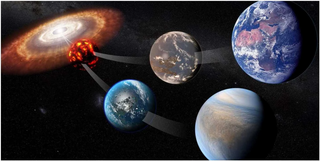
An Earth analog, also called an Earth analogue, Earth twin, or second Earth, is a planet or moon with environmental conditions similar to those found on Earth. The term Earth-like planet is also used, but this term may refer to any terrestrial planet.

NEO Surveyor, formerly called Near-Earth Object Camera (NEOCam), then NEO Surveillance Mission, is a planned space-based infrared telescope designed to survey the Solar System for potentially hazardous asteroids.
Ann E. Wehrle is an astronomer currently studying black holes and quasars at the Space Science Institute in Boulder, CO. More specifically, she studies energy emission mechanisms from relativistic jets near black holes in quasars and active galactic nuclei. Ann lives in La Canada Flintridge, CA with her husband and their two children. Ann says that she is fascinated by black holes because they embody the most extreme conditions in the known universe.

The Habitable Exoplanet Observatory (HabEx) is a space telescope concept that would be optimized to search for and image Earth-size habitable exoplanets in the habitable zones of their stars, where liquid water can exist. HabEx would aim to understand how common terrestrial worlds beyond the Solar System may be and determine the range of their characteristics. It would be an optical, UV and infrared telescope that would also use spectrographs to study planetary atmospheres and eclipse starlight with either an internal coronagraph or an external starshade.

ASTERIA was a miniaturized space telescope technology demonstration and opportunistic science mission to conduct astrophysical measurements using a CubeSat. It was designed in collaboration between the Massachusetts Institute of Technology (MIT) and NASA's Jet Propulsion Laboratory. ASTERIA was the first JPL-built CubeSat to have been successfully operated in space. Originally envisioned as a project for training early career scientists and engineers, ASTERIA's technical goal was to achieve arcsecond-level line-of-sight pointing error and highly stable focal plane temperature control. These technologies are important for precision photometry, i.e., the measurement of stellar brightness over time. Precision photometry, in turn, provides a way to study stellar activity, transiting exoplanets, and other astrophysical phenomena.

